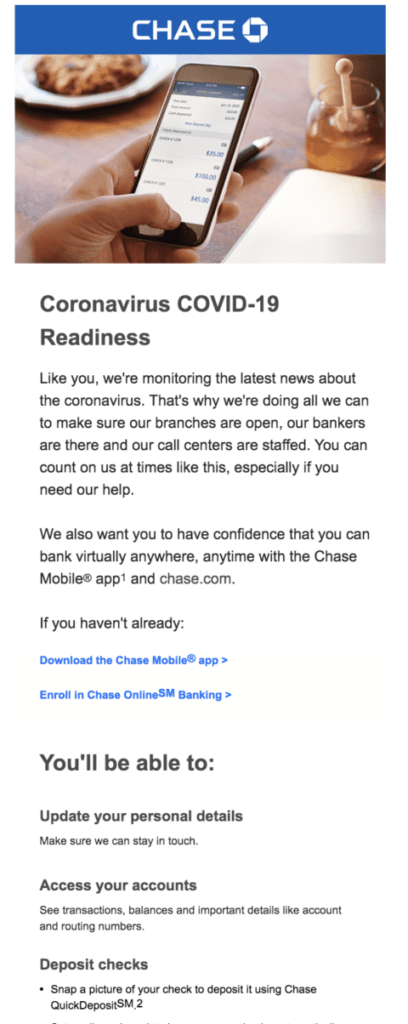The COVID-19 crisis currently unfolding is affecting everyone in some form, but certain industries and local businesses will carry a heavier burden in terms of customer communications. Besides the airline and travel industry, many local businesses are sending out their own COVID-19 email updates as residents second-guess whether or not they should go to the gym, continue with their facials they booked a month ago, or even stop by their local coffee shop or brewery.
Some companies have dedicated teams and vendors who prepare year-round for crisis communications in situations just like this. But many smaller businesses and brands do not. Our recent Email Benchmark and Engagement Study revealed that, on average, people subscribe to and receive email from around 50 brands and businesses. This week, I would wager that many of those businesses have sent emails, or are planning on sending emails, on what steps they are taking to reduce the risk of COVID-19.
This post provides some best practice tips if you want to send your own COVID-19 email update and are looking for some guidance.
First, do you need to send a COVID-19 email?
Just because you are seeing all of these COVID-19 emails pop up in your inbox doesn’t mean that you must send your own. In no way should you be sending emails about COVID-19 just to “capitalize” on the frenzy. Only send these emails if you have a legitimate business need to do so.
Some use cases that would necessitate extra crisis communication include:
- Company event updates or cancellations
- Information on how to access the services of a company remotely
- Updates from businesses with high foot-traffic where individuals may come into close contact with each other
Please note: This is not an exhaustive list of when you need to send a COVID-19 email, but hopefully, this helps you decide what the next steps should be for your business.
Sender and subject line: be clear about what’s inside
Now is not the time to play around with changing your sender name. We recommend that senders avoid using personal names because it may confuse the recipient. They might not recognize the sender and glaze over the email. In situations like this, clarity is the number one priority and being consistent will help you achieve a clear message.
We recommend providing clear, succinct subject lines. In promotional emails, putting an intriguing spin can be an effective way to entice recipients to open your emails. But, for the COVID-19 email, keep to simple subject lines such as “Our Response to COVID-19.” If your recipient uses or visits your business, they will likely want to know more and open this email.
Adjust your brand voice and tone
Maybe your brand voice is typically super cheeky and free-spirited. Now would be a good time to adjust the tone and focus on the facts and developments within your control. But don’t over-correct so much and write in such a solemn or dire tone that you increase the recipient’s stress.
When writing the body copy of your COVID-19 email, connect with your recipient by acknowledging their anxiety, but keep a calm, objective tone throughout the email.
Your reader will understand the shift given the situation, and your brand will actually seem much more human.
Focus on action
Your recipients are going to be most interested in the actions you are taking to reduce the risk and spread of COVID-19. Consider providing those actions in a bulleted list so the reader can efficiently skim through your measures. Have you hired additional cleaners to deep clean your gym every week? This is what your recipient wants to know.
Chase Bank recently sent out a COVID-19 email with useful resources and tips for how to access the bank remotely:
Consider sectioning out your email into what you as a business are doing and what your customers can do to help. A Precious Child is a non-profit organization in the Denver Metro that provides gently used clothing and supplies for qualifying families. They outlined their preventive measures, as well as what they ask of volunteers, in easy to read bullet points:

During any sort of crisis, there is typically a sea of opinions and voices out there on news outlets, Twitter accounts, and more. Don’t use your COVID-19 email as an opportunity to add to that noise.
Avoid taking an editorial stance on a crisis unless you work for an agency that is dedicated to doing so.
Your recipients will sniff that out, and there is a good chance they may disagree with your views. As a result, you only risk your brand reputation once the crisis is over.
Focus on the facts you have, and what actions you are taking because of those facts.
Be ready to adapt
As with any rapidly-changing situation, today’s developments can quickly become outdated. Be ready to respond to any other COVID-19 developments or updates so you can keep your employees and customers safe and healthy.
Hopefully, these tips will help you as you navigate the COVID-19 developments and provide effective email communications during this time. For the most accurate and up to date information on the spread of COVID-19, refer to the Center for Disease Control (CDC) and the World Health Organization’s (WHO) COVID-19 Dashboard.
